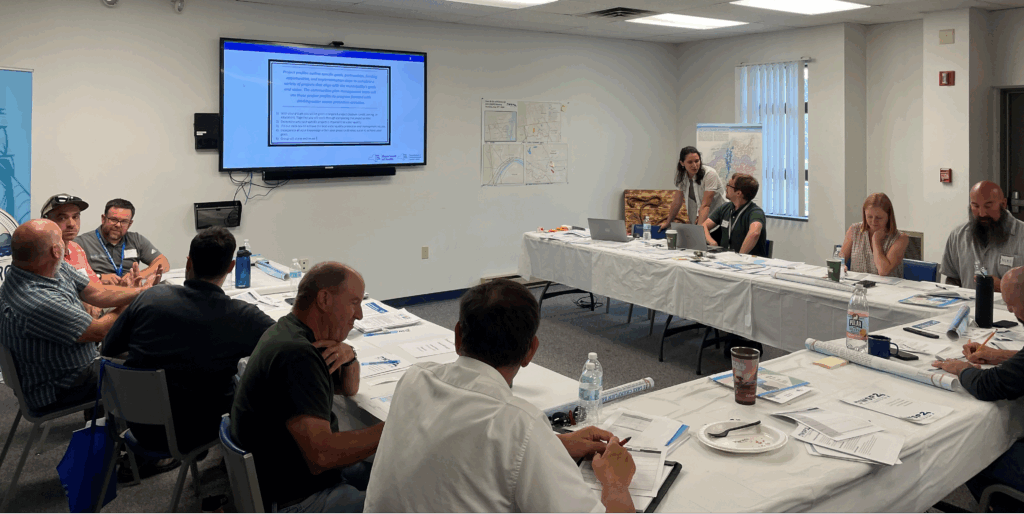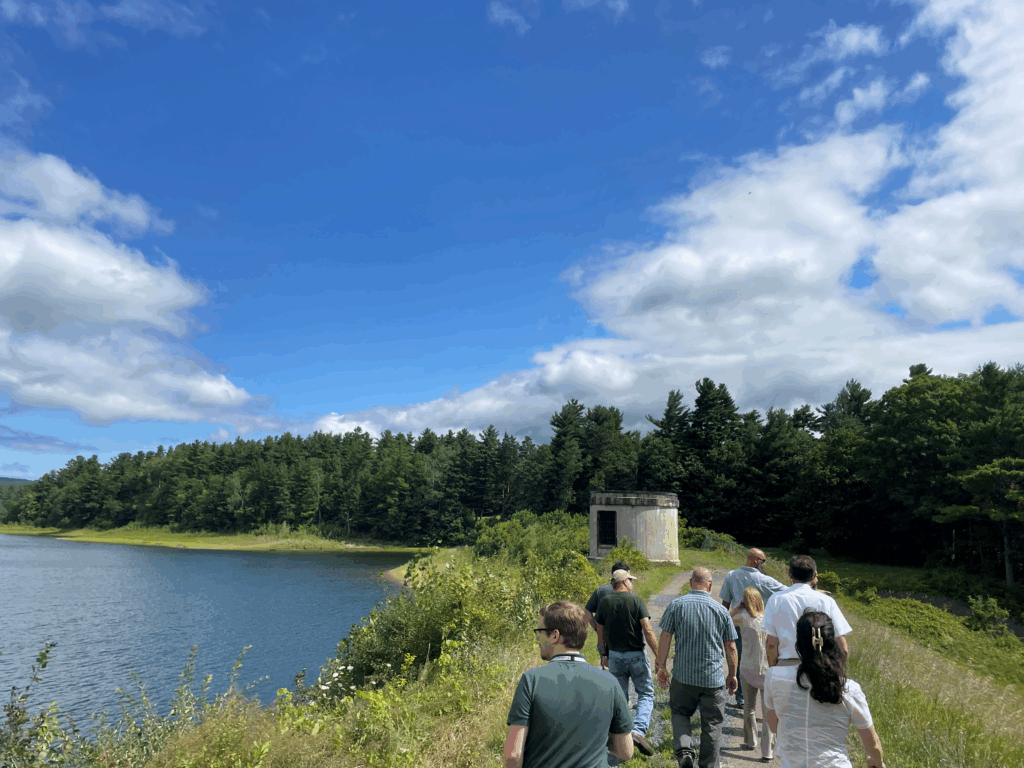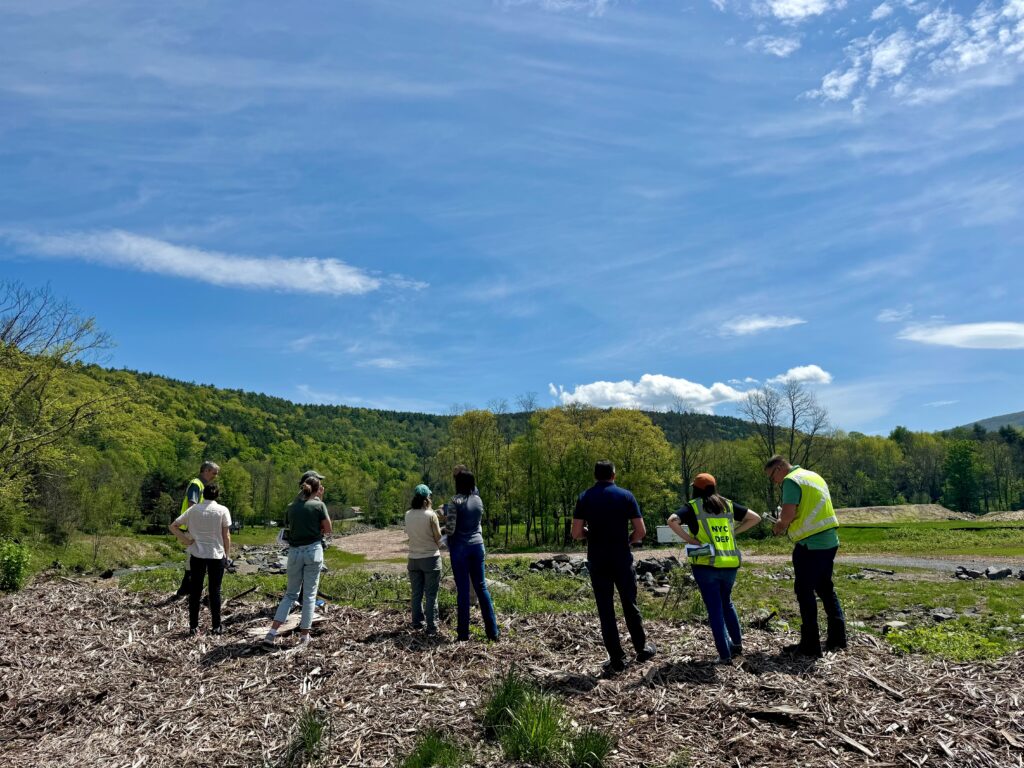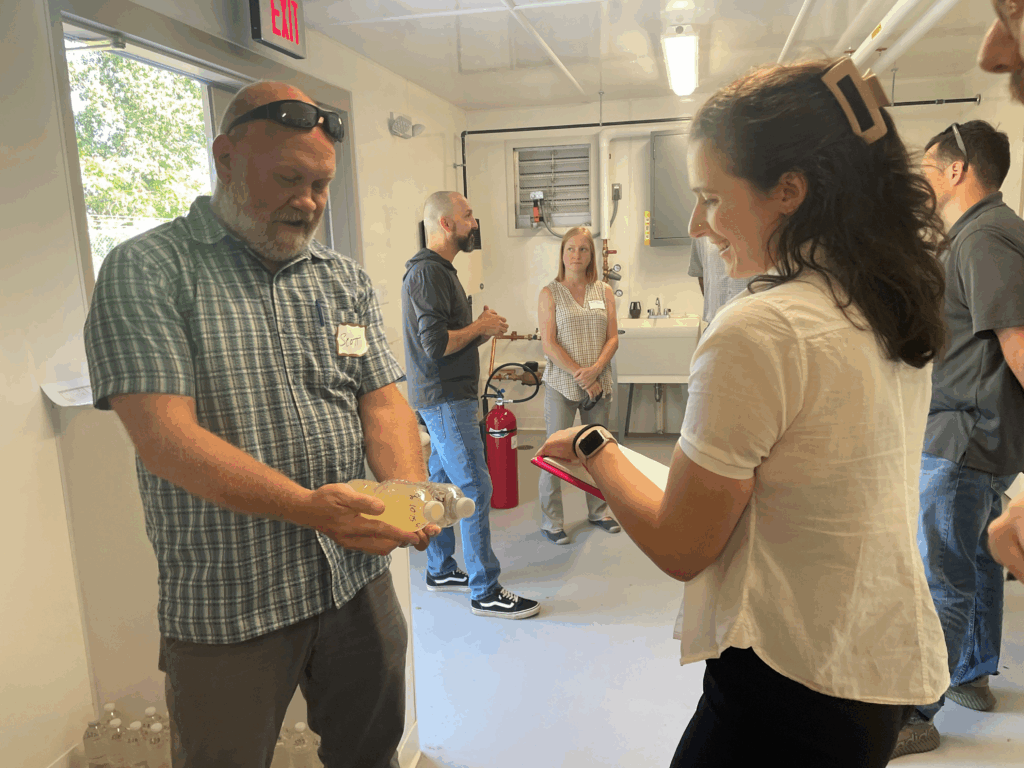New York state’s Drinking Water Source Protection Program (DWSP2) is a locally led, state-supported program that empowers municipalities to proactively protect their public drinking water sources. Since the inception of the program in 2019, DWSP2 has evolved and grown, supporting more than 100 municipalities with 2.5 million water consumers.
The program is committed to increasing awareness and protection of source water throughout the state. By collaborating with program partners and gathering feedback from DWSP2 participants and technical assistance (TA) providers through interviews, meetings, and data analysis, DWSP2 is able to make continuous improvements in order to best suit the needs of all parties. The voluntary nature of the program provides municipalities the opportunity to be proactive in the methods used to protect source waters.
Proactive vs. Reactive
State agencies tend to operate in a reactive capacity – for example: a contamination event occurs, an emergency response follows, and then a remediation takes place. A more successful approach can be in anticipating those contamination issues and reducing or eliminating their risk.
This proactive approach is the foundation of DWSP2. It positions the state to work with communities to identify potential contaminant sources that can impact source waters and proactively implement ways to remove those threats.
Once these sources are identified, communities get assistance with the selection and implementation of suitable methods to proactively protect drinking water. This includes information on applicable partners to work with and potential funding opportunities. Through this assistance, the DWSP2 program furthers a municipality’s ability to anticipate source water-related issues, make informed decisions, and utilize the appropriate management tools.
Community Driven
DWSP2 is a program built for its participants, requiring a municipality or water system owner to be the driver. This makes it more likely that the plan will be fully implemented and successful. To better achieve this, every DWSP2 community first forms a stakeholder group during plan development and then a program management team (PMT) during the implementation phase.
DWSP2 stakeholder groups consist of active community members, local organizations and public officials. They help build partnerships at the municipal level, ensure that plan development does not fall on one person, bring in expertise (e.g., water treatment operators, agricultural experts, planners, etc.), and open new lines of communication.
After the plan development phase, the PMT is formed to carry out implementation activities. In addition, PMTs share reports/updates on actions to keep the community informed on progress. A successful DWSP2 plan depends on a dedicated group who will withstand staff turnover and ensure that the plan is used, maintained, and updated.
“Pulling together a stakeholder group early on was probably one of the most important aspects of our program,” said Ben Slotman, P.E., director of the Department of Public Works, Ellicottville. “I think we had a fairly active group, which our plan benefitted from. I could see how other communities may struggle to pull together a diverse group, so being proactive and engaging with your technical assistance provider are two pieces of advice I would give.”

Agency Collaboration
The New York State Department of Environmental Conservation (NYSDEC) and the New York State Department of Health (NYSDOH) each have a role in protecting public drinking water sources and are equal partners in DWSP2, with support from the state’s Department of Agriculture and Markets (AGM) and Department of State (DOS). The roles of NYSDEC and NYSDOH mainly follow the agencies’ missions and capacity related to the division of program responsibilities. NYSDEC develops and continues growth of DWSP2, and NYSDOH works directly with the communities to provide technical assistance and implement the program. While they may work on different aspects of the program, the agencies work closely together. Individual program staff are in daily contact with each other, and the two agencies meet weekly as a team to discuss issues and make final decisions.
DWSP2 supports NYSDEC’s mission to conserve, improve and protect New York’s natural resources, which includes water bodies. NYSDEC has had a lead role in writing the DWSP2 “A Framework for Creating a Drinking Water Source Protection Program Plan” (“DWSP2 Framework,” or “Framework”), which provides a roadmap for creating a source water protection plan, including implementation activities and next steps.
NYSDEC’s involvement stems from many of the department’s programs (regulatory and nonregulatory) in some way protecting water. Also, from DWSP2 empowering communities to protect their local waterbodies by implementing environmentally sound practices that will have a lasting effect further aligns with the agency’s purpose. NYSDEC has existing capacity and experience in receiving state funding and procuring contracts. Therefore, it made sense to have NYSDEC manage the program’s state funding, which is used to hire the TA providers and fund source water-related projects. NYSDEC oversees the TA providers to ensure they stay on track and assist when roadblocks arise.
“I’ve had the privilege of witnessing DWSP2 grow from an idea into a collaborative program that successfully safeguards the environment, and public health,” said Susan Van Patten, water chief, NYSDEC. “From those early days of laying DWSP2’s groundwork to the program’s current impact on New York’s public water supplies, it has been incredibly rewarding to see the way our collective efforts are shaping the state’s clean water future.”
NYSDOH oversees the delivery of suitable drinking water, frequently working with suppliers to help improve their public supply, which is a struggle for some communities due to limited resources and support. The department provides a structure which communities can use to garner local support, ensure high quality drinking water, and potentially avoid high treatment costs. Staff work directly with communities as a TA provider during plan development. Additionally, NYSDOH coordinates with NYSDEC to ensure that DWSP2 plans meet all components of the program. As communities transition from plan development to implementation, NYSDOH staff serve as their long-term advisors, especially as needs change.
NYSDEC and NYSDOH have some overlapping responsibilities, such as participating in DWSP2 outreach and ensuring plans meet requirements. Since the program is voluntary, outreach is critical. Both agencies present the environmental and public health benefits at conferences and write outreach materials. In addition, the two agencies hold TA providers and communities to program standards as they work toward state acceptance of their DWSP2 plans. Through weekly meetings and consistent updates, the two agencies ensure the program meets high standards.
Since the inception of DWSP2, the New York State Department of State (NYSDOS) and the New York State Department of Agriculture and Markets (NYSAGM) have been supporting agencies involved in developing the program and drafting the framework. Protecting public water supplies involves land use considerations such as zoning, comprehensive planning, and waterfront revitalization. NYSDOS serves as a key partner to assist DWSP2 in making critical related land use decisions. Agriculture is an important industry in New York and many public water supplies have agricultural activities in their watershed. NYSAGM provides a link to county soil and water conservation districts, which frequently work with farmers and serve as key local partners in protecting drinking water. The four agencies share program progress and ideas for improving DWSP2.
NEIWPCC has supported the state agencies and enhanced the program’s reach. The state sought out NEIWPCC because of its mission as a regional commission that helps the states of the Northeast preserve and advance water quality.

Free Technical Assistance
NYSDEC and NYSDOH, in collaboration with NYSAGM, NYSDOS, and other source water protection organizations, created the DWSP2 Framework, a guide and template for TA providers and communities to use so that DWSP2 plans are grounded in science, adhere to state and federal laws and regulations, and ensure projects are implementable and, where appropriate, fundable. This promotes consistency between each community’s plan and the state-wide program.
Municipalities accepted into DWSP2 receive comprehensive, results-oriented assistance to complete a plan that is unique to their needs. At no cost to the community, the state pairs DWSP2 participants with at least one of 15 TA providers covering all of New York. Using the framework, TA providers coordinate the formation of stakeholder groups, interpret data, create maps, identify source water protection strategies, provide guidance on funding, and help the municipality start implementing protection actions. Communities walk away from this assistance with a clear path forward on how to safeguard the environment and public health through source water protection.
Once work is completed on a DWSP2 plan, a community’s TA provider will send it to NYSDEC and NYSDOH for state acceptance. After the plan is determined to align with the key elements of the DWSP2 framework, a community can begin to work with their TA provider on implementing several actions outlined in their plan.
“Creating a Plan can seem challenging if you don’t know where to start,” said Dan Lang, P.G., deputy director, NYSDOH Center for Environmental Health. “The free technical assistance offered by this program gives communities the resources they need to identify local priorities and implementation strategies.”

Action Oriented: Implementation
Some communities have found the transition from planning into implementation difficult. To address this issue, TA providers begin by identifying up to three priority issues from the DWSP2 plan to implement immediately. Examples include:
- Writing and application assistance.
- Local law gap analyses.
- Aquifer protection overlay district.
- Community education and outreach.
- Intermunicipal agreement toolkit.
Communities typically work with their TA providers between six to twelve months to accomplish some early action implementation activities.
Community Spotlight: Ithaca
Beginning in 2021, the city of Ithaca participated in DWSP2, with the intention to build on the work previously completed in its 2004 Source Water Assessment Program (SWAPP) plan. Several potential contaminants threatened Ithaca’s water quality, while droughts and limited reservoir management contributed to decreasing water quantity. Ithaca’s DWSP2 stakeholder group worked with their TA provider to develop and implement a program that was specific to their community and drinking water sources to address their concerns. After the city’s plan received state acceptance in 2022, Ithaca moved to implementation to make their source water protection goals a reality.
As part of the implementation process, Ithaca began to address its core water quality concerns by performing a build-out analysis. The analysis explored the impacts of various development scenarios and provided community leaders with decision-making tools. With assistance from TA providers, the city successfully applied for and secured a $45,000 grant award, “Build-out Analysis Modeling for Scenario Planning.” Through the funding obtained from this grant, Ithaca was able to inform future land use planning within their drinking water source protection area to support the long-term health and sustainability of Six Mile Creek, which serves approximately 30,000 residents.
Community Spotlight: Ellicottville
The town and village of Ellicottville participated in DWSP2 in 2021. The municipalities’ vision, as described in their plan, was to ensure that their water supply − drawn from the Great Valley Aquifer − continues as a reliable and cost-effective source of excellent quality drinking water, meeting the highest public health standards. To this end, the stakeholder group prioritized actions to prevent contaminants from seeping into groundwater and protect their source water area from future development. Following state acceptance in 2022, the PMT, with support from their TA provider, kicked off implementation efforts.
One specific action was the development of an Aquifer Protection Overlay District (APOD). An APOD applies an additional set of source water protection regulations to those of the existing, underlying primary zoning district(s). Keeping the priority goals in mind, a list of recommended amendments and new laws are gathered. The communities then have the option to choose which recommendations they would like implemented into the existing body of legislation, or to include these recommendations as part of an APOD.
Outreach and Program Awareness
DWSP2 agency staff put considerable effort into raising program awareness and increasing exposure to target audiences. The team takes a multi-faceted outreach approach to communicate with all interested parties, from municipal officials to local stakeholders. Bi-monthly newsletters provide an opportunity for DWSP2 to educate thousands of readers on source water-related topics and program updates. Social media engagement – through related posts on Facebook and Instagram – furthers this effort. The DWSP2 team actively seeks opportunities to present and table at conferences and trainings. State staff note that tabling at conferences provide attendees with a more relaxed atmosphere to have an open dialogue about their source water.
The most direct way for a community to initiate involvement in DWSP2 is through the agency’s interest form, in which they provide contact information, describe public water supply details, and explain the reasons behind seeking enrollment in the program. Agency staff then provides them with a community-specific presentation about the program. The interest form is available on the DWSP2 website and given out at conferences. Each of these avenues have proven effective.
Using a combination of newsletters, social media engagement, presentations/tabling, and the interest form makes it possible for DWSP2 to cover many communication channels and promote consistent engagement with the program before, during, and after enrollment.

Data Storage and Analysis
To collect and analyze data to improve the statewide program, the DWSP2 team is modernizing its collection from participating communities. DWSP2 will be piloting an online platform to host data in a central location for participants. The system, when launched, will collect each plan’s data and track progress. As part of continued program improvement, the DWSP2 team anticipates using this data to identify areas that are successful and those that need additional attention. For example, DWSP2 will have a better understanding of the rate of plan implementation and which strategies are being selected by each community. This type of information is important to understand how to best support municipalities with their source water protection goals.
More information about these implementation activities, including specific examples executed by DWSP2 communities and their TA providers, can be found in the DWSP2 Newsletter.
This article was originally published in the Spring 2025 edition of Interstate Waters magazine. This article was written by the following contributors: Susan Van Patten, Watershed Section B Section chief, NYSDEC; Kristin Martinez, environmental program specialist, NYSDEC; Tyler Bobko, environmental analyst, Drinking Water Source Protection Program, NYSDEC; Pat Palmer: research scientist, NYSDOH; Pauline Wanjugi, research scientist, NYSDOH; Colleen Bradley, NEIWPCC environmental analyst, drinking water specialist, NYSDOH; Ryan Bell, NEIWPCC program manager, drinking water specialist, NYSDOH.